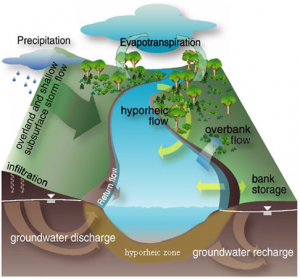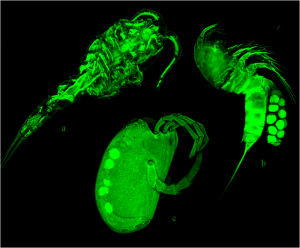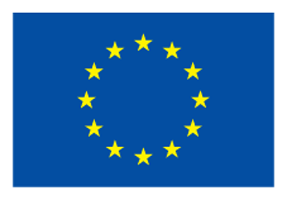
February 8, 2013
Hyporheic is the buffer zone located at the interface between surface and true groundwater, and is recognized also as a rich ecotone from biological viewpoint. At this level there is an exchange of water, nutrients, organic matter and organisms between the surface and groundwater and vice-versa, but the hyporheic function also as an intermediary zone for the transfer of pollutants from the surface river to the water table. Groundwater crustaceans and especially its stygobite fraction (species developing their entire life cycle exclusively in groundwater) living in this compartment are good predictors for the water quality. They are highly sensitive to any disturbance in their environment (both quality and quantity) and consequently their risks to be threatened are higher that turn to greater chances of extinction.
Sanda Iepure, IMDEA Water
Groundwater accounts for over 97% of all freshwaters available on earth (excluding glaciers and ice caps) being the largest drinking freshwater reservoir in the world (almost 75% EU inhabitants depends on groundwater for their water supply) (Gibert & Culver, 2009). It represents also a significant resource for industry and agriculture and an important component of the global hydrological cycle (Gibert, 2001; Danielopol et al., 2003). But groundwater can be recognized also as complex ecosystems varying in structure, dimension, and connectivity, and harbor a vast and almost unrecognized diversity of groundwater fauna (Danielopol, et al., 2003). Globally, it is only in the last years that the groundwater biodiversity has been acknowledged (Danielopol, et al., 2006; Gibert & Culver, 2009; Gibert et al., 2009). The groundwater fauna have been shown to be in some areas as diverse as those of the associated surface ecosystems, and especially in karst terrains (Gibert & Culver, 2009). The groundwater biodiversity has attracted much consideration in the last years due to the distinct assemblages when compared to surface water ecosystems. The groundwater lacks or have reduced diversification of insects, allowing the development of crustaceans. Consequently this makes groundwater to be more similar to marine waters than to freshwaters (Deharveng et al., 2009). Furthermore, the endemism in groundwater is very common, and species are narrowly distributed on small areas, sometimes reduced to one single aquifer or even to a single site location (Gibert et al., 1994; Gibert & Culver, 2009).
The groundwater fauna is a living component that highly illustrates the quality of the subterranean waters. A number of studies have demonstrated the applicability of groundwater fauna for monitoring purposes related to any kind of disturbance (i.e. water pollution or drought) (Malard et al., 1996; Dumas et al., 2001; Hahn, 2006; Malard et al., 2007; Bork et al., 2009). Specifically the obligate groundwater-dwelling species termed stygofauna (Styx = in greek mythology Styx was the river formed at the boundary between the Earth and Underworld, guarded by Phlegyas, who passes the
souls from one side to another of the river), and its stygobite fraction (species restricted to groundwater only) have the strongest potential to be reliable indicators of groundwater ecosystem health. Stygobites display specific adaptations to live in subterranean waters: morphologic characters (i.e. blind, non-pigmented, small and elongated body shape), metabolic (i.e. low metabolic rate, long life, low reproduction rate, etc.) and ecological (i.e. narrower tolerance range being stenotopic with the necessity of strict environmental conditions, low dispersion capacity). Because of these strict specializations they are highly sensitive to any disturbance in their environment (both quality and quantity) and consequently their risk to be threatened are higher that turn to greater chances of extinction.
Along a river, the hyporheic zone is the transitional ecotone between the river and the adjacent aquifer, reaching approximately 1 m depth, and extends to the lateral sides of the river channel (Boulton, 2001) (Fig. 1). Hyporheic is considered a buffer zone and an interface between surface and true groundwater, but is recognized also as a rich ecotone from biological viewpoint (Gibert J. & Culver, 2009). The functional significance of the hyporheic zone in rivers consists in exchange the water, nutrients, organic matter and organisms between the surface and groundwater and vice-versa. In comparison with the river channel which is more dynamic, the residence time of the water is short, the current generate turbulences, and the transport of nutrients, sediments and biota are unidirectional; the hyporheic water are more stable, with longer residence time of the water in sediments, the water flow is more continuous, the zone is permanent in darkness and there is no significant sediment changes in the river bed structure (Boulton et al., 1988; Boulton et al., 2008). The hyporheic function also as an intermediary zone for the transfer of pollutants from the surface river to the water table. This zone has to some extent attenuation capacity of some pollutants, but this depends by several factors, like sediments permeability, porosity, and residence time of the water in the sediments, to mention but a few. In several cases the hyporheic do not provide sufficient auto-purification, thus affecting the water quality and biota at this level and further on deep underground. Several pollutants once entered in groundwater, can be difficult or sometimes impossible to be naturally removed from the system.
Figure. 1. Major pathways of water movement emphasizing (1) groundwater flow, (2) overland flow and shallow subsurface flow from adjacent uplands, and (3) instream water sources such as overbank flow, bank storage and hyporheic exchange (http://books.nap.edu).
Groundwater contamination and extraction have been identified as critical risks for underground environment and biodiversity worldwide. The overexploitation of groundwater for human and industrial purposes that increase in the last decades, cause an evident decline of groundwater quality and quantity. Hence the Groundwater Directive 2006/118/EC (GWD) have been settled, in response to the requirements of Article 17 of the Water Framework Directive (EU-WFD, 2000) and to expand the scope of water protection to groundwater. GWD highlights the need for more research on groundwater ecosystem functioning and ecosystem services, to achieve the ´good status´ with the two components ´ecological´ and ´chemical´ by approaching interdisciplinary studies (Danielopol et al., 2003; Weiss et al., 2008). To accomplish this target a set of abiotic and biotic criteria must be considered that can be further use to diagnose the cause of an existing impact and to provide an early warning of groundwater ecosystem decline.
At IMDEA-Water, the groundwater “ecological status” within the Jarama basin (Manzanares, Henares, Tajuña, Jarama and Tajo) will be assessed by estimating crustacean biodiversity and biotic interractions, pooled with hydrological and chemical characteristics of groundwater. The ecological risk assessment will be achieved using model organism’s micro-crustaceans (Fig. 2a, b) that are known to develop large populations in groundwater, either testing their potential to be used as bio-indicators for anthropogenic impacts. The research will be focused on the groundwater compartment most susceptible to pollution, the hyporheic zone, being further examined its role as an intermediary transfer area of pollutants from the surface rivers down to the water table, and the effect on the hyporheic crustaceans communities. The research will provide a better understanding of the mechanisms by which crustacean biodiversity in the hyporheic zone is obtained, which is essential for the development of sustainable groundwater management strategies.
Figure 2. Hyporheic fauna. a – Diacyclops sp. (Cyclopoida, Copepoda), b – Harpacticoida (Copepoda), c – Frontipodopsis reticulatifrons (Acarina) (Confocal microscopy images performed at Museo Nacional de Ciencias Naturales, Madrid, by Sanda Iepure and Antonio Valdecasas, MNCN, Madrid).




